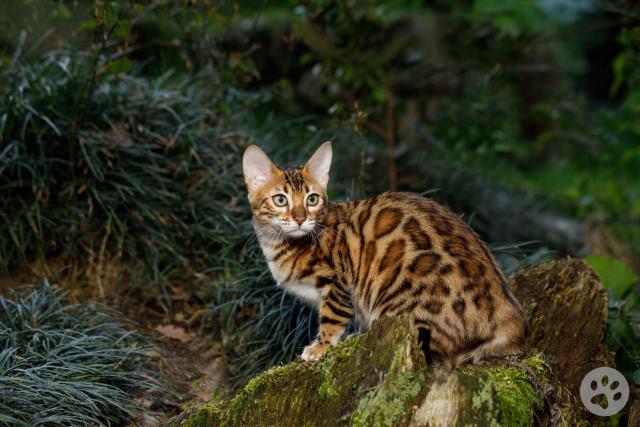Overview
The Bengal cat originated in America, by crossing the Asian Leopard cat with domestic cats, to produce a medium-sized, domestic cat with the striking markings of the wild cat. There are reports of the earliest crossings as far back as 1889; however, it wasn’t until the 1970s that the breeding of the Bengal began in earnest, and it wasn’t until the 1980s and 1990s when breed registries finally accepted the Bengal as a breed in its own right.
Appearance
The Bengal is a long and lean animal, often looking bigger than it really is due to being a muscular, athletic cat. They have longer hind legs and carry their tail low. They are an average to large-sized cat breed. The Bengal’s coat is short, dense, luxurious and silky to the touch. It is often referred to as a pelt. They need little grooming. Some Bengals can carry the recessive gene for long-hair and when mated together, can result in long-haired offspring, called a Cashmere Bengal.
Colour
Bengals can be found in a variety of coat colours, including Brown Spotted, Mink Spotted tabby, Seal Lynx Point (or Snow), Sepia and Silver. They have two types of markings; Spotted and Marble, and are the only breed of domestic cat to have rosette markings. However, there are many more variations of colours and markings available; within the Brown Spotted category alone, the Bengal can be red, brown, grey, black, ticked, rosetted, spotted or clouded. The Bengal can closely resemble the markings of a Leopard.
Personality
The Bengal is an active, quick, agile cat breed, as well as being intelligent and playful. Many Bengal owners say their cat naturally likes to play retrieving games, and enjoys playing in water. Bengal cats are usually confident, curious characters.
Health
Hypertrophic Cardiomyopathy (HCM) is a common genetic disease in Bengal cats. This is a disease in which the heart muscle becomes abnormally thick, making it harder for the cat’s heart to pump blood. There is no cure for HCM and treatment has proved to be of no effect. There is no genetic screening available so breeders are only able to determine if their cats are suitable for breeding by having the cat’s heart scanned annually or semi-annually, to determine no HCM is present.
Bengal cats are also predisposed to Bengal Progressive Retinal Atrophy (PRA or PRA-b). This is when degeneration of the retina occurs, causing progressive loss of vision, and can lead to complete blindness. A simple DNA test can determine whether a cat is clear or a carrier, then responsible breeding can occur.
Another common genetic ailment which affects Bengal cats is Pyruvate Kinase Deficiency; where there is a defect in the gene responsible for normal cell function. When this happens, red blood cells die prematurely causing a reduction in the number of circulating red blood cells, leading to anaemia and reduced ability to carry oxygen to the body’s organs and tissues. Clinical signs of cats affected by PK-deficiency include weakness, lethargy, pale mucus membranes, diarrhoea, lack of appetite, weight loss, poor-looking coat and jaundice. Again, a simple DNA test or blood test are available and should be carried out to determine whether an individual is clear or a carrier, to allow responsible breeding to follow.
Are you a Bengal breeder? Please contact us admin@pedigree-pets.com to help expand our knowledge.



